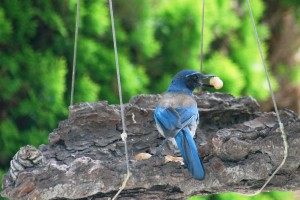
Photo credit: Bobbie Hedges
“Oh look, a Blue Jay!”
If you made that exclamation in the South Bay, then it’s not a Blue Jay…it’s a Scrub Jay, more specifically the Western Scrub Jay or Aphelocoma californica.
Blue Jays and Scrub Jays are members of the family Corvidae, the scientific name for the closely related group of birds that includes crows and jays. According to The Sibley Guide to Bird Life & Behavior, crows and jays are known for their sneaky smarts, bold behavior, loud calls, outgoing personalities, and strong bills, plus sexy legs that are smooth on the back and scaly on the front.
But how do you know for sure it’s not a Blue Jay sitting in your back yard? For starters, Blue Jays rarely frequent California. They prefer the habitats of the eastern and mid-western United States and southern areas of Canada.
Still not convinced? Are you certain that the only Blue Jay living in Southern California happens to be in your backyard?
This can easily be verified by looking at the jay’s head. The Blue Jay has a sweeping crest on top like a feathered crown, giving it a distinguished profile, while the Scrub Jay has a normal round head. So if your resident Blue Jay doesn’t possess a feathery upsweep on top, well then once and for all it’s a Scrub Jay.
But is it a male or female scrub jay? Excellent question.
For many birds, identifying males and females is easy because their feathery attire gives them away. Males tend to be brightly colored to attract the perfect mate while females dress more conservatively in earthy tones to blend with their surroundings and better conceal their nests.
Not so for crows and jays. Males and females look exactly the same. The only visual difference is that females are usually slightly smaller, a distinction that is imperceptible when peering at the Scrub Jay fluttering about your backyard.
The Western Scrub Jay, like its jay brethren, eats seeds, insects and sometimes fruit, but absolutely loves eating nuts, especially acorns. Jays store nuts and seeds in the ground for future dining and in the process have done a better job populating local forests with new trees than Jonny Appleseed, especially Western Scrub Jays.
According to Introduction to California Birdlife: “By one estimate, a single scrub jay may stash as many as 5,000 acorns a season, but only retrieves 30 percent. Indeed the Miwok name for Western Scrub-Jay is ‘the one who plants oaks.’”
Other estimates place the Scrub Jay’s stashing abilities closer to 30,000 according to Tom Langen, associate professor at Clarkson University who studied Scrub Jays and their decision-making abilities. But the Scrub Jay’s imperfect memory is the true link to prospering oaks.
“Nuts are scatter-hoarded, meaning each nut gets its own hiding spot,” explains Langen. “My impression, from watching retrieval, is that Scrub Jays don’t remember storing particular nuts, but do remember the kinds of places that they store nuts. It is like looking for your keys – you may not remember where you laid your keys, but you know the kinds of places you lay your keys and look there.”
While busy populating forests with misplaced acorns, Western Scrub Jays also enact their own version of Robin Hood. Well, actually it’s just plain thievery – after spying on another scrub jay concealing its golden acorns, the voyeur swoops in and steals the goods.
The All About Birds website suggests that the Western Scrub Jay has a conscious, or even guilt. Once a bandit Scrub Jay escapes safely with stolen goods and arrives at its secret hideaway, the jay takes one final look over the shoulder to make sure the coast is clear before stashing the nut away for future enjoyment. Instead of guilt, this sounds like the classic moves of a master burglar.
So residents beware! If you plan on storing acorns in your backyard…make sure that no one is watching, especially the blue skull-capped jay lurking nearby. And if you spot one, remember to shout, “Oh look, a Scrub Jay!”
I just loved reading this article: Scrub Jay: that’s not a blue jay. I’m printing it out for ‘ol time sake. I volunteer for a Wildlife organization and I’m always trying to improve my knowledge about wildlife. Thank you for such an fun, interesting and educational explanation!
I have scrub jays come right up to my sliding glass door and literally beg for food. They’ll just stare at me like a dog until I feed them. Funniest behavior I’ve ever seen in a bird.
Love this site! I’ll be back!
A correction… there are scrub jays and stellar blue jays in Southern California, specifically Crestline California and all the way up to the top of that mountain in Big Bear Lake California. (San Bernardino National Forest.
Pretty snarky attitude throughout. I saw a blue jay with the full spiked head / crown of blue and white this year (2019) in Montecito, Santa Barbara CA. So put that in your pipe and smoke it